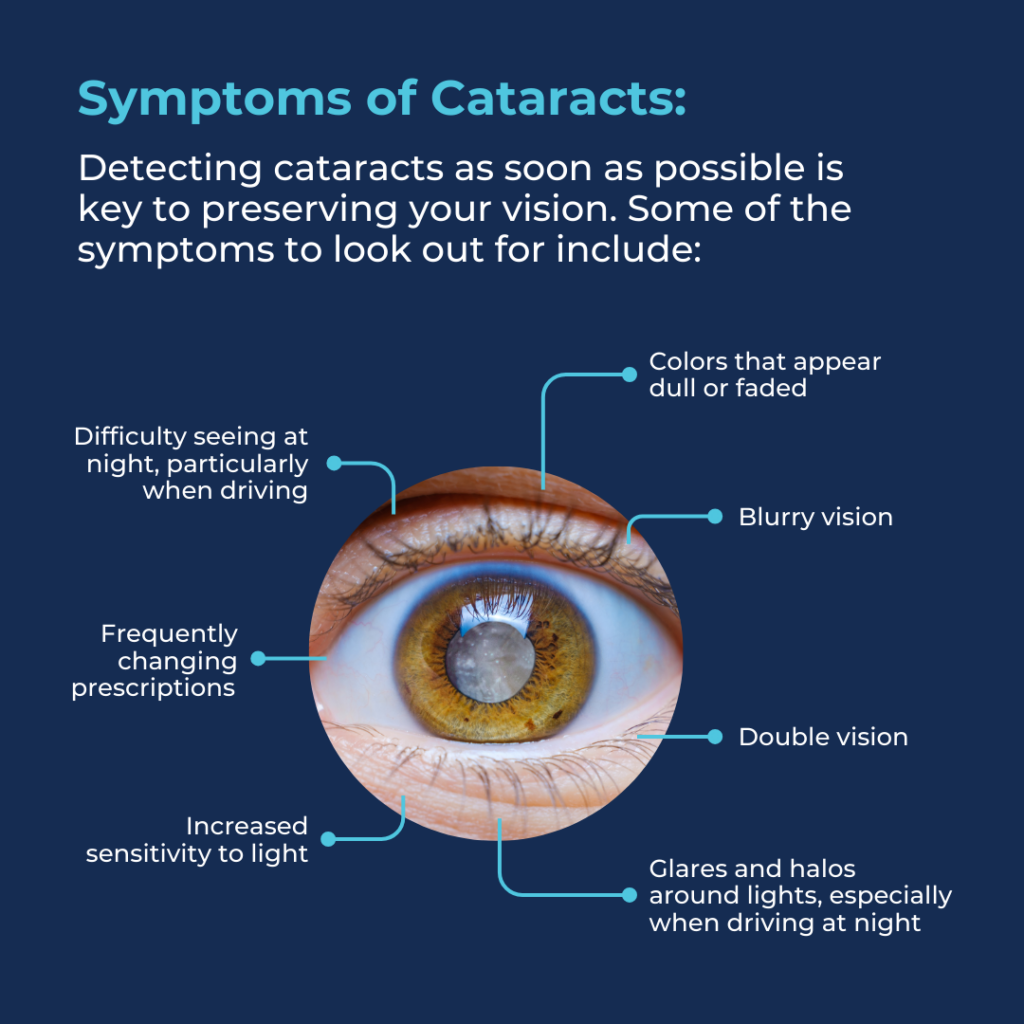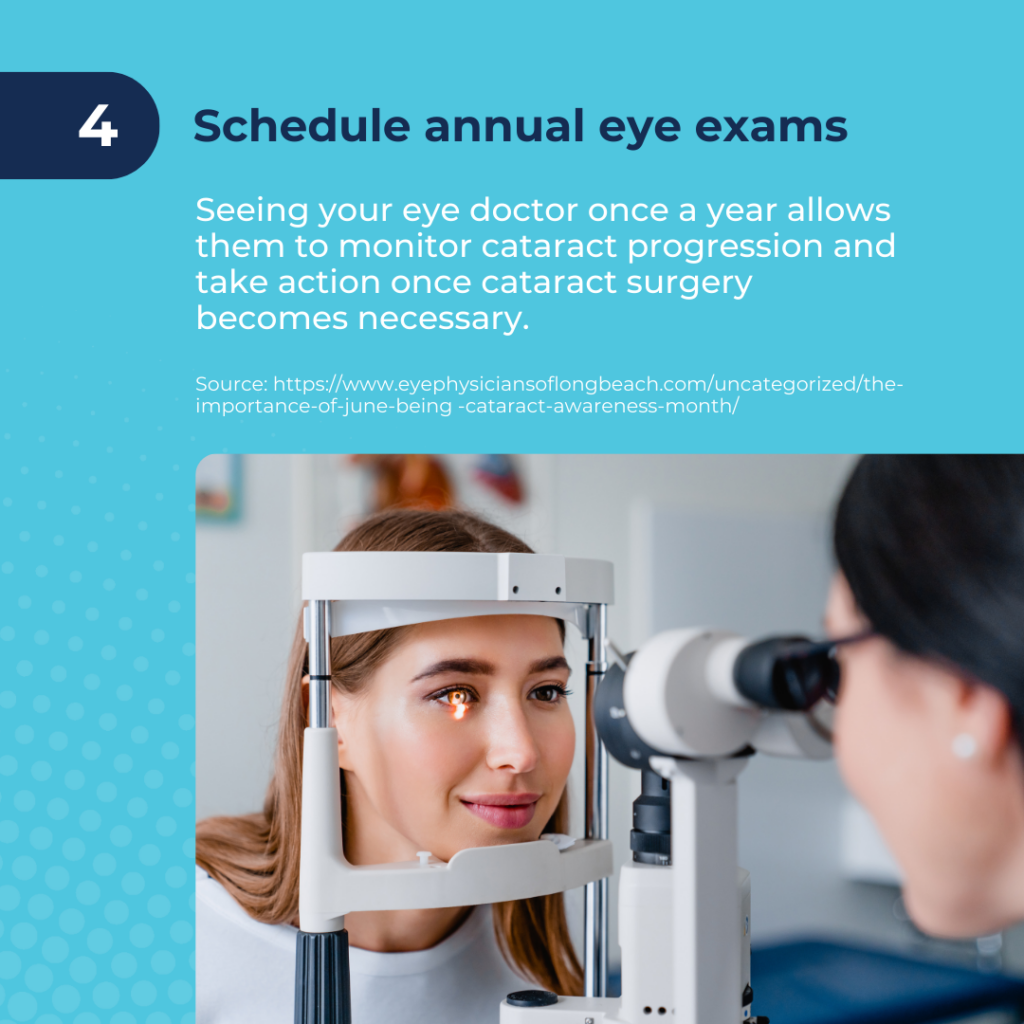Cataract Awareness Month
June 17, 2024
Cataract Awareness Month: Clear Up the Facts and Protect Your Vision
June isn’t just about beach trips and barbecues—it’s also International Cataract Awareness Month! As we enjoy those bright summer days, it’s the perfect time to focus on something we often take for granted: our vision. Let’s dive into the world of cataracts, uncovering what they are, how they affect us, and what we can do to keep our eyes healthy and clear.
What Are Cataracts?
Imagine your eye is a camera. At the front of this camera, the lens captures light and focuses it onto the retina at the back of your eye. This retina then sends the images to your brain, creating what you see. Now, picture this lens getting foggy or cloudy, like trying to snap a photo through a misty window. That’s what happens when you have a cataract. This cloudiness makes your vision blurry and colors less vibrant, turning everyday tasks into frustrating challenges.
Why Are Cataracts a Big Deal?
Cataracts aren’t just a minor inconvenience—they’re a leading cause of vision loss. According to the National Eye Institute, over half of all Americans aged 80 and older either have cataracts or have had surgery to remove them. The Centers for Disease Control and Prevention (CDC) highlights that cataracts are the top cause of vision loss in the United States and a primary cause of blindness globally【4†source】. These statistics underline why it’s so important to talk about cataracts and how to manage them.
How Do Cataracts Form?
To really get what a cataract is, let’s take a quick look at the eye’s anatomy. Your eye’s lens is made up mostly of water and proteins. These proteins are usually arranged perfectly to keep the lens clear and let light pass through. But as you age, some of these proteins can clump together and start to cloud a small part of the lens. Over time, this cloudiness can grow, making it harder and harder to see.
Types of Cataracts
Cataracts aren’t all the same. They come in different types depending on where and how they develop:
- Nuclear Cataracts: These form in the center of the lens and are most commonly associated with aging. They can initially make your near vision better (hello, reading without glasses!), but over time, they turn the lens yellow or brown, which severely impacts your vision.
- Cortical Cataracts: These start as white, wedge-shaped streaks on the outer edge of the lens. As they grow, they extend to the center and interfere with light passing through the lens.
- Posterior Subcapsular Cataracts: These form at the back of the lens and often develop more quickly than other types. They’re more common in people taking steroids, those with diabetes, or people with extreme nearsightedness.
- Congenital Cataracts: Some babies are born with cataracts or develop them in childhood, often in both eyes. These can be due to genetics or infections the mother had during pregnancy.
Living with Cataracts
Cataracts can seriously impact your daily life. Imagine struggling to read your favorite book because the words are blurry or finding it hard to drive at night because of halos around lights. These limitations can be frustrating and isolating, highlighting the importance of early detection and treatment.
Who’s at Risk?
Several factors can increase your chances of developing cataracts:
- Age: Aging is the most common cause. Most people will have some form of cataract by the time they’re 80.
- UV Exposure: Long-term exposure to the sun’s ultraviolet rays can increase your risk.
- Medical Conditions: Diseases like diabetes can heighten the risk.
- Lifestyle Choices: Smoking and excessive alcohol consumption are linked to a higher risk.
- Injury: Eye injuries can lead to cataracts.
- Medications: Long-term use of steroids can cause cataracts.
- Genetics: Family history can also play a role【4†source】.

Spotting the Symptoms

Cataracts usually develop slowly, so you might not notice symptoms right away. But here are some signs to watch for:
- Blurry Vision: Things look foggy or blurry.
- Faded Colors: Colors seem less vibrant.
- Glare: Lights seem too bright or glaring.
- Halos Around Lights: You see halos around lights, especially at night.
- Frequent Prescription Changes: You need to change your glasses or contact lens prescription more often.
- Trouble with Night Vision: Driving at night becomes harder.
Preventing and Slowing Down Cataracts
While you can’t completely avoid cataracts, you can take steps to protect your eyes and slow their progression:
- Eat a Healthy Diet: Load up on foods rich in vitamin C, antioxidants, and leafy green vegetables. These nutrients support eye health.
- Quit Smoking and Limit Alcohol: Giving up smoking and drinking in moderation can lower your risk.
- Protect Your Eyes from the Sun: Wear sunglasses that block UV rays and a wide-brimmed hat when you’re outside.
- Get Regular Eye Exams: Annual eye exams can catch cataracts early and monitor their progression【4†source】.




Treating Cataracts
If cataracts start interfering with your daily life, your doctor might suggest cataract surgery. This common and successful procedure involves removing the cloudy lens and replacing it with a clear artificial one. Millions of people regain clear vision through this surgery every year.
What to Expect from Cataract Surgery
Cataract surgery is typically an outpatient procedure. Here’s what you can expect:
- Before Surgery: Your eye doctor will do tests to measure your eye’s size and shape. This helps them pick the right lens implant for you.
- During Surgery: The surgeon makes a small incision in your eye, removes the cloudy lens, and inserts a new, clear artificial lens.
- After Surgery: Recovery is usually quick, with many people noticing improved vision within a few days. You might need to use eye drops and avoid strenuous activities for a few weeks.
New Techniques and Innovations
Advances in cataract surgery have made it even more effective and less invasive. Techniques like laser-assisted cataract surgery allow for greater precision and faster recovery times. Plus, new types of intraocular lenses (IOLs) can help reduce your need for glasses after surgery.
Real-Life Stories of Transformation
Hearing from people who’ve had cataract surgery can be incredibly inspiring. Take Jane, a 75-year-old gardener who found it increasingly hard to see her flowers clearly. After her surgery, Jane was thrilled to see her garden in full color again, reigniting her love for gardening.
Or Bob, a retired pilot who missed flying due to his poor vision. Post-surgery, Bob not only regained clear vision but also got back in the cockpit for fun, reclaiming a cherished part of his life.
Busting Myths About Cataracts
There are many myths about cataracts and their treatment. Let’s clear up a few:
- Myth: Only the elderly get cataracts. Fact: While age is a major risk factor, younger people and even children can get cataracts.
- Myth: Cataracts can be treated with medication or eye drops. Fact: The only effective treatment for cataracts is surgery.
- Myth: You should wait until a cataract is “ripe” before having surgery. Fact: Cataract surgery can be done as soon as vision problems interfere with your daily life.
The Role of Genetics
Genetics can play a big role in developing cataracts. If your parents or grandparents had cataracts, you might be at higher risk. Knowing your family history and discussing it with your eye doctor can help with early detection and management.
The Future of Cataract Treatment
The field of eye care is constantly evolving, with researchers exploring new treatments and technologies to improve outcomes for cataract patients. Some exciting future advancements include:
- Gene Therapy: Scientists are looking into gene therapy to prevent or treat cataracts by targeting genetic causes.
- Nanotechnology: Nanoparticles might deliver targeted treatments directly to the lens, potentially reversing early-stage cataracts without surgery.
- Artificial Intelligence: AI could enhance diagnostic accuracy and personalize treatment plans, ensuring the best outcomes for patients.
Fun and Quirky Eye Facts
Let’s have some fun with these eye facts:
- The human eye can distinguish around 10 million different colors.
- You blink about 15-20 times per minute. That’s around 4.2 million times a year!
- The muscles that control your eyes are the most active muscles in your body.
- If the human eye were a digital camera, it would have a resolution of 576 megapixels.
- Some animals, like the mantis shrimp, have incredibly complex eyes that can see polarized light and ultraviolet.
Getting the Community Involved
Cataract Awareness Month is a great time to engage with your community. Think about organizing or joining local events like vision screenings, educational workshops, or fundraisers for vision health charities. These activities not only raise awareness but also build a sense of community and support.
Eye-Friendly Foods
Diet plays a crucial role in eye health. Here are some foods to include in your diet:
- Carrots: Rich in beta-carotene, which your body turns into vitamin A, essential for good vision.
- Leafy Greens: Spinach, kale, and other greens are high in lutein and zeaxanthin, antioxidants that protect against cataracts.
- Fish: Salmon, tuna, and other fatty fish are packed with omega-3 fatty acids, supporting overall eye health.
- Citrus Fruits: Oranges, grapefruits, and lemons are high in vitamin C, an antioxidant that protects the eyes.
- Nuts and Seeds: Almonds, sunflower seeds, and walnuts are excellent sources of vitamin E, which helps protect eye cells from damage.
Emotional and Psychological Impact
Vision loss from cataracts can be tough emotionally. It can lead to frustration, helplessness, and isolation. Addressing these feelings is as important as treating the physical symptoms. Support groups, counseling, and staying connected with loved ones can make a big difference.
Innovations in Research
Research is ongoing, with new ways to prevent and treat cataracts constantly being explored. Some exciting areas of study include:
- Pharmacological Interventions: Scientists are looking into medications that could slow down or reverse cataract formation.
- Stem Cell Therapy: Stem cells could potentially regenerate damaged lens tissue, offering a non-surgical treatment option in the future.
- Advanced Imaging Techniques: Improved imaging technologies are enabling earlier detection and more precise monitoring of cataract progression.
How You Can Help
There are many ways you can contribute to Cataract Awareness Month:
- Spread the Word: Share information about cataracts on social media using hashtags like #CataractAwarenessMonth.
- Volunteer: Offer your time to local vision health organizations or participate in community events.
- Donate: Support research and patient care by donating to charities focused on vision health.
- Educate: Talk to your friends and family about the importance of regular eye exams and healthy lifestyle choices.
Conclusion
International Cataract Awareness Month is a vital time to highlight a condition that affects millions. By spreading awareness, encouraging regular eye exams, and promoting healthy lifestyle choices, we can all help reduce the impact of cataracts and improve the quality of life for those affected. Remember, clear vision is a precious gift—take steps to protect it.
For more information on cataracts, their treatment, and how you can get involved in Cataract Awareness Month, visit Prevent Blindness【4†source】.





